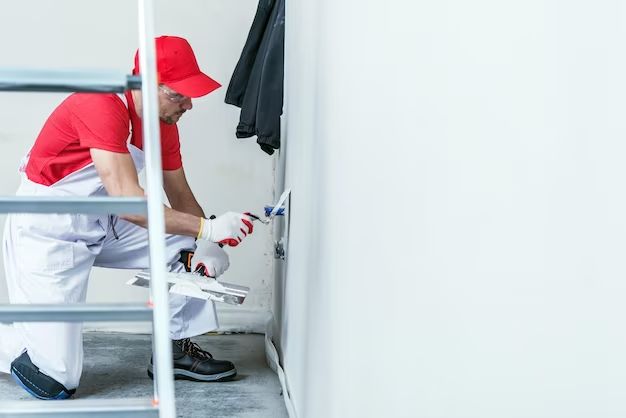Preparing drywall for painting is an important step that ensures the paint adheres properly and provides a smooth, professional-looking final product. Here are the key steps for prepping drywall before painting.
Page Contents
- 1 Fill Any Holes or Imperfections
- 2 Clean the Drywall
- 3 Sand the Drywall
- 4 Spot Prime if Needed
- 5 Apply Drywall Primer
- 6 Inspect for Flaws and Make Repairs
- 7 Caulk Along Trim and Joints
- 8 Apply Two Coats of Paint
- 9 Clean Up
- 10 Allow Adequate Dry Time Before Use
- 11 Tips for Prepping Drywall Before Painting
- 12 FAQs About Preparing Drywall for Paint
- 12.1 Does new drywall need to be primed before painting?
- 12.2 Should drywall be sanded before priming?
- 12.3 How long does spackle need to dry before priming?
- 12.4 What kind of roller should be used to paint new drywall?
- 12.5 Should drywall seams be caulked or spackled?
- 12.6 How long does primer need to dry before painting drywall?
- 13 Conclusion
Fill Any Holes or Imperfections
Start by inspecting the drywall and filling any holes, cracks, or imperfections with drywall spackle or joint compound. Allow the filler to fully dry and sand smooth. This provides an even surface for the paint.
Clean the Drywall
Use a dry cloth to wipe away any dust, dirt, or debris on the drywall’s surface. You can also use a vacuum with a soft brush attachment. Grease, oil, or soap that is on the surface can cause paint adhesion problems, so make sure the drywall is free of these contaminants.
Sand the Drywall
Lightly sand the entire surface using fine 120-150 grit sandpaper. This “roughens” the drywall and allows the paint to grip properly. Be careful not to sand too aggressively, which can damage the paper surface of the drywall.
Spot Prime if Needed
For severely stained areas, spot prime just those locations with an appropriate primer before applying full primer. Common spot priming scenarios include covering grease stains in kitchens, marker on walls, smoke or soot stains from candles/fireplaces, and more.
Apply Drywall Primer
Next, apply a high-quality drywall primer designed for new drywall. The primer will seal the surface and provide a uniform base that allows the final paint coats to look even and smooth. Use a brush, roller, or sprayer to apply a thin, even coat according to the primer’s directions.
Inspect for Flaws and Make Repairs
Once the primer has dried, inspect to make sure small flaws like air bubbles, cracks, rough edges or any missed spots have been filled and sanded smooth. Touch up these areas with more spackle, primer and sandpaper so the surface is flawless before painting.
Caulk Along Trim and Joints
Use painter’s caulk to fill any visible gaps or cracks where the drywall meets trim, along seams, at inside corners or around openings like windows and doors. Allow the caulk to fully cure before painting.
Apply Two Coats of Paint
Following the paint manufacturer’s instructions, apply at least two coats of high quality interior paint in your desired sheen. Use a brush for trim and edges and a roller for large areas. Allow proper drying time between coats. The primer and multiple finish coats will provide maximum durability.
Clean Up
After the final coat has dried, remove any painter’s tape and clean up any messy edges with a putty knife or sandpaper. Use drop cloths to protect floors and surfaces from drips. Properly clean brushes, rollers and other painting tools.
Allow Adequate Dry Time Before Use
Leave the room undisturbed for at least the manufacturer’s recommended drying time to prevent damage to the new paint job. Once fully dry, the room is ready for furniture, decor and regular use again.
Tips for Prepping Drywall Before Painting
- Fill gouges, holes and imperfections for optimal results
- Wipe away dust and debris before priming
- Lightly sand to roughen the surface
- Spot prime any stained/damaged areas first
- Apply a quality drywall primer before painting
- Caulk gaps and seams for a seamless look
- Use proper painting tools – brush, roller, painter’s tape
- Allow each coat to fully dry between applications
- Be patient – adequate dry time prevents damage
FAQs About Preparing Drywall for Paint
Does new drywall need to be primed before painting?
Yes, it is highly recommended to apply a drywall primer before painting new drywall. The primer seals the surface so the paint goes on smoothly and evenly.
Should drywall be sanded before priming?
Lightly sanding helps the primer and paint adhere properly. Use fine 120-150 grit sandpaper and be careful not to over-sand which can damage the drywall surface.
How long does spackle need to dry before priming?
Spackle or joint compound typically needs 24 hours to fully cure and dry before sanding smooth and applying primer.
What kind of roller should be used to paint new drywall?
A 1/2″ to 3/4″ nap roller cover works well for smoothly painting most drywall surfaces. Adjust roller nap for textured surfaces.
Should drywall seams be caulked or spackled?
Spackle is used to cover the seams, while caulk goes over the joints after priming. This fills any cracks and provides a seamless painted surface.
How long does primer need to dry before painting drywall?
Drywall primer typically dries within 2-4 hours. Allow the manufacturer’s recommended drying time before applying the finish paint coats.
Conclusion
Properly preparing drywall creates the ideal surface for a successful paint job. Following these fundamental steps takes a bit of time and diligence upfront, but prevents many common paint problems. Ensuring the drywall surface is cleaned, sanded, primed, caulked and fully dried will allow the finish paint to look its best. With adequate prep work completed first, you can look forward to a smooth, professional painted finish.
